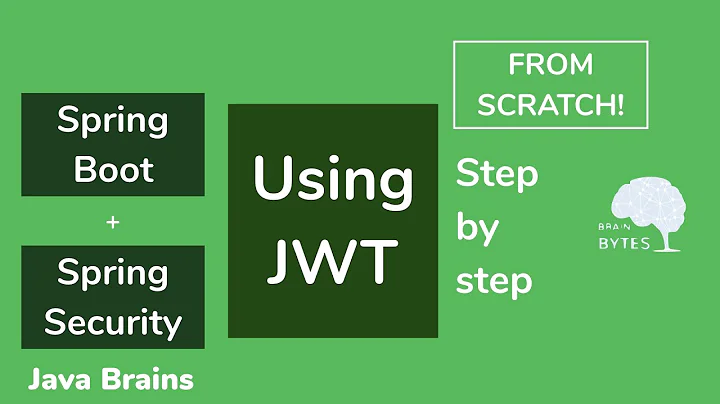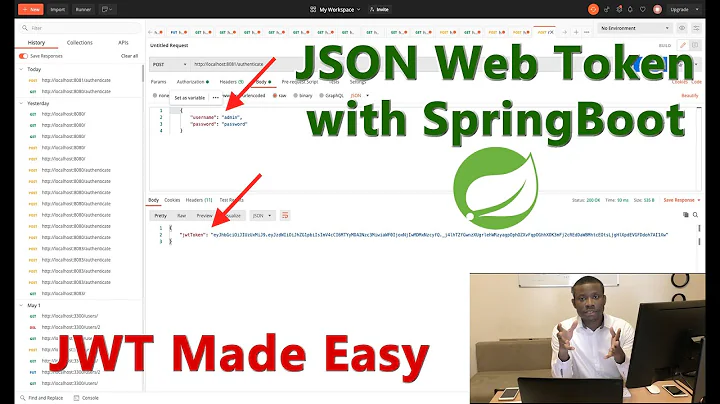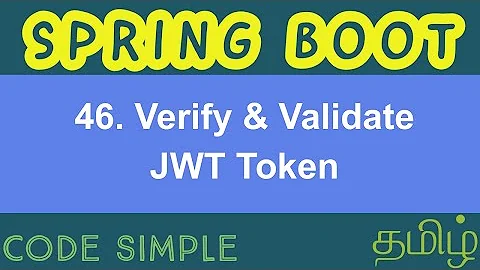Extract Currently Logged in User information from JWT token using Spring Security
Solution 1
The first thing you need to do is store the user information inside the JWT when it is created, then you have to extract it when it is used. I had a similar situation and I solved it by extending both the TokenEnhancer and JwtAccessTokenConverter.
I use the TokenEnhancer to embed my extended principal of type CustomUserDetailsinside the JWT additional information.
public class CustomAccessTokenEnhancer implements TokenEnhancer {
@Override
public OAuth2AccessToken enhance(OAuth2AccessToken accessToken, OAuth2Authentication authentication) {
Authentication userAuthentication = authentication.getUserAuthentication();
if (userAuthentication != null) {
Object principal = authentication.getUserAuthentication().getPrincipal();
if (principal instanceof CustomUserDetails) {
Map<String, Object> additionalInfo = new HashMap<>();
additionalInfo.put("userDetails", principal);
((DefaultOAuth2AccessToken) accessToken).setAdditionalInformation(additionalInfo);
}
}
return accessToken;
}
}
And then manually extract the extended principal when building the Authentication object when processing an authenticated request.
public class CustomJwtAccessTokenConverter extends JwtAccessTokenConverter {
@Override
public OAuth2Authentication extractAuthentication(Map<String, ?> map) {
OAuth2Authentication authentication = super.extractAuthentication(map);
Authentication userAuthentication = authentication.getUserAuthentication();
if (userAuthentication != null) {
LinkedHashMap userDetails = (LinkedHashMap) map.get("userDetails");
if (userDetails != null) {
// build your principal here
String localUserTableField = (String) userDetails.get("localUserTableField");
CustomUserDetails extendedPrincipal = new CustomUserDetails(localUserTableField);
Collection<? extends GrantedAuthority> authorities = userAuthentication.getAuthorities();
userAuthentication = new UsernamePasswordAuthenticationToken(extendedPrincipal,
userAuthentication.getCredentials(), authorities);
}
}
return new OAuth2Authentication(authentication.getOAuth2Request(), userAuthentication);
}
}
and the AuthorizationServer configuration to tie it all together.
@Configuration
@EnableAuthorizationServer
public class AuthorizationServerConfig extends AuthorizationServerConfigurerAdapter {
@Autowired
private AuthenticationManager authenticationManager;
@Autowired
private UserDetailsService userDetailsService;
@Autowired
private DataSource dataSource;
@Bean
public JwtAccessTokenConverter accessTokenConverter() {
CustomJwtAccessTokenConverter accessTokenConverter = new CustomJwtAccessTokenConverter();
accessTokenConverter.setSigningKey("a1b2c3d4e5f6g");
return accessTokenConverter;
}
@Bean
public TokenStore tokenStore() {
return new JwtTokenStore(accessTokenConverter());
}
@Bean
@Primary
public DefaultTokenServices tokenServices() {
DefaultTokenServices defaultTokenServices = new DefaultTokenServices();
defaultTokenServices.setTokenStore(tokenStore());
defaultTokenServices.setSupportRefreshToken(true);
return defaultTokenServices;
}
@Bean
public TokenEnhancer tokenEnhancer() {
return new CustomAccessTokenEnhancer();
}
@Bean
public PasswordEncoder passwordEncoder() {
return new BCryptPasswordEncoder();
}
@Override
public void configure(ClientDetailsServiceConfigurer clients) throws Exception {
clients.jdbc(dataSource).passwordEncoder(passwordEncoder());
}
@Override
public void configure(AuthorizationServerEndpointsConfigurer endpoints) throws Exception {
TokenEnhancerChain tokenEnhancerChain = new TokenEnhancerChain();
tokenEnhancerChain.setTokenEnhancers(Arrays.asList(tokenEnhancer(), accessTokenConverter()));
endpoints
.tokenStore(tokenStore())
.tokenEnhancer(tokenEnhancerChain)
.authenticationManager(authenticationManager)
.userDetailsService(userDetailsService);
}
@Override
public void configure(AuthorizationServerSecurityConfigurer security) throws Exception {
security.passwordEncoder(passwordEncoder());
security.checkTokenAccess("isAuthenticated()");
}
}
I am then able to access my extended principal in my resource controller like this
@RestController
public class SomeResourceController {
@RequestMapping("/some-resource")
public ResponseEntity<?> someResource(Authentication authentication) {
CustomUserDetails userDetails = (CustomUserDetails) authentication.getPrincipal();
return ResponseEntity.ok("woo hoo!");
}
}
Hope this helps!
Solution 2
In your REST Service, add the OAuth2Authentication Class as an argument
@RequestMapping(value = "/{id}/products", method = RequestMethod.POST)
public ResourceResponse<String> processProducts(OAuth2Authentication auth) {
Springboot will automatically map the logged-in user details to this object. Now, you can do the following to access the username
auth.getPrincipal().toString()
Related videos on Youtube
mayur tanna
Updated on September 16, 2022Comments
-
mayur tanna over 1 year
I have implemented JWT and LDAP Authentication using Spring Security Oauth2. It seems to be working fine and I can login with my LDAP credentials.
Now, there is one requirement that I need to use the currently logged in user info to save details in database - specifically like when that user add/update a new record. I tried to get that using Spring security way using
SecurityContextHolder.getContext().getAuthentication().getDetails()but it doesn't return all that information which I have in JWT. It just returns Remote IP,the JWT token value and authenticated true. It doesn't even return name().
I am new to JWT, so not sure if I need to extract it by reading that token and even how we can achieve it.
Any pointers will be appreciated.
Thanks.



![[Spring Boot Security] #19 Database Authentication - Implement User Details Service](https://i.ytimg.com/vi/TDuVY8PFU3Q/hq720.jpg?sqp=-oaymwEcCNAFEJQDSFXyq4qpAw4IARUAAIhCGAFwAcABBg==&rs=AOn4CLA36-RZvlC2kyK0IrhLu9x5q9ZLig)



